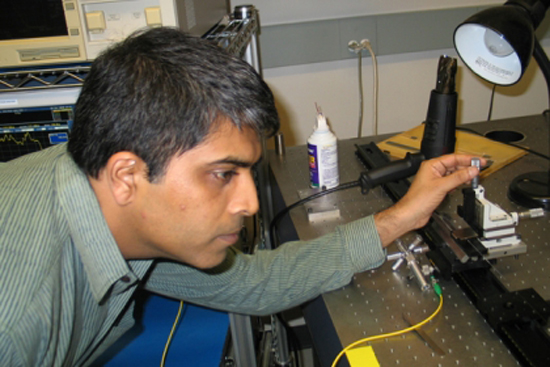The Internet Is Getting Bigger
ENG prof corkscrews light to move more data faster

ENG Professor Siddharth Ramachandran has demonstrated a promising new way to boost fiber-optic data rates. Photo courtesy of the College of Engineering
If you thought there was no problem with internet bandwidth, consider that on a typical weeknight, Netflix alone serves up almost a third of all internet traffic to homes in North America. And that’s without streaming Game of Thrones. Now think about the explosion of mobile devices and their insatiable demand for more data faster.
In fact, the people who worry about such things as bandwidth capacity have been stressing out for years about where the next breakthrough will come from. Now it seems there’s a good chance that it will come from the College of Engineering, where Siddharth Ramachandran, an associate professor of electrical and computer engineering, has developed a new fiber-optic technology that can transmit vastly greater amounts of data at very low cost.
Described in the June 28 issue of the journal Science, the technology uses donut-shaped laser light beams called optical vortices, also known as orbital angular momentum (OAM) beams, which were thought to be unstable in fiber until Ramachandran proved otherwise. Working with researchers from the University of Southern California, Tel Aviv University, and OFS-Fitel, a fiber optics company in Denmark, he demonstrated not only the stability of the beams in optical fiber, but also their potential to boost internet bandwidth.
“Our discovery of design classes in which they are stable has profound implications for a variety of scientific and technological fields that have exploited the unique properties of OAM-carrying light, including the use of such beams for enhancing data capacity in fibers,” says Ramachandran, who was recently named by the IEEE Photonics Society as one of six Distinguished Lecturers for the 2013-2014 term, an award that honors researchers who have made outstanding technical, industrial, or entrepreneurial contributions to the field of lasers and electro-optics.
Traditionally, bandwidth has been enhanced by increasing the number of colors, or wavelengths of data-carrying laser signals—essentially streams of ones and zeros—sent down an optical fiber, where the signals are processed according to color. A newer technique sends the light through a fiber along distinctive paths, or modes, each carrying a cache of data from one end of the fiber to the other. Unlike the colors method, the data streams of ones and zeros from different modes mix together; determining which data stream came from which source requires computationally and energy-intensive digital signal processing algorithms.
Ramachandran’s approach, funded by the Defense Advanced Research Projects Agency, combines both strategies. It packs several colors into each mode in specially designed fibers that compel the light to travel in a corkscrew pattern, and it appears to prevent the different paths from melding. He and his collaborators recently created an OAM fiber with four modes (an optical fiber typically has two), and showed that for each OAM mode, they could send data through a one-kilometer fiber in 10 different colors and achieve a transmission capacity of 1.6 terabits per second.
How fast is that? Fast enough to transmit eight Blu-ray DVDs per second.
Mark Dwortzan can be reached at dwortzan@bu.edu.
A version of this article was originally published on the ENG Electrical & Computer Engineering website.
Comments & Discussion
Boston University moderates comments to facilitate an informed, substantive, civil conversation. Abusive, profane, self-promotional, misleading, incoherent or off-topic comments will be rejected. Moderators are staffed during regular business hours (EST) and can only accept comments written in English. Statistics or facts must include a citation or a link to the citation.